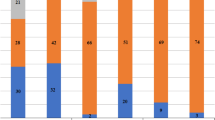Abstract
Background
Biochemical toxicology in suicides provides a template to improve preventive interventions in cases of suicide. The menu for biochemical toxicological analysis in coroners’ cases is not prescriptive in Ireland or in the United Kingdom. The aim of the study was to confirm that reliance on the results of an immunoassay screen for drugs of abuse and common analgesics in order to select samples for compound confirmation by gas chromatography-mass spectrometry is likely to understate the potential role of drugs in suicide. Blood and urine samples were analyzed using enzyme immunoassay, alcohols by gas chromatography and urines were screened by Bio-Rad’s Rapid Emergency Drug Identification (REMEDi) system. Laboratory data from analysis of 132 cases of suicide, including 101 cases of hanging revealed that 83 % were male confirming suicide as a male epidemic. Overall, alcohol was a factor in 57 %, benzodiazepines in 26 %, cannabinoids in 11 %, opioids in 19.7 %, sympathomimetics in 7.5 %, cocaine in 4.5 %, antidepressants 22 %, antipsychotics in 10 %, hypnotics in 5 %, and antihistamines in 4 % of these cases. Screening compounds in cases of hanging and other suicides should extend beyond the narrow focus of alcohol and illicit drugs to include a wide spectrum of psychoactive and other compounds as a standard procedure. The wide range of licit and illicit compounds found in these cases reflects current experience and dictates the necessity for chromatographic screening with mass spectroscopy confirmation in all cases as best practice.
Similar content being viewed by others
References
Forrest AR (1993) ACP Broadsheet no 137. Obtaining samples at post mortem examination for toxicological and biochemical analyses. J Clin Pathol 46:292–296
Royal College of Pathologists: (2005) Guidelines on autopsy practice—best practice scenarios. Scenario 3. Suspected illicit drugs updated Sept 2005
Soft/AAFS Forensic Toxicology Laboratory Guidelines. (2006). College of American Pathologists website. (accessed 20 November 2008)
Brett AS (1988) Implications of discordance between clinical impression and toxicological analysis in drug overdose. Arch Int Med 148:437–441
Stewart DC (1982) The use of the clinical laboratory in the diagnosis and treatment of substance abuse. Pediatric Ann 11:669–682
Sadeg N, Francois G, Petit B, Dutertre-Catella H, Dumontet M (1997) Automated liquid-chromatographic analyzer used for toxicology screening in a general hospital: 12 months’ experience. Clin Chem 43:498–504
Demedts P, Wauters A, Franck F, Neels H (1994) Evaluation of the REMEDi drug profiling system. Eur J Clin Chem Clin Biochem 32:409–417
Kelleher MJ, Corcoran P, Keeley HS (1997) Suicide in Ireland statistical, social and clinical considerations. Arch Suicide Res 3:13–24
Suicide in Ireland (2001). A national study. Departments of Public Health
Burns A, Goodall E, Moore T (2008) A study of suicides in Londonderry, Northern Ireland, for the year period spanning 2000–2005. J Forensic Legal Med 15:148–157
Mac Giolla Bhain P (2010) The bottom line is that eight out of ten suicides are males. Sunday Independent 22 August
Houses of the Oireachtas. (2006). Joint Committee on Health and Children. Seventh Report. The high level of suicide in Irish society
Bedford D, O’Farrell A, Howell F (2006) Blood alcohol levels in persons who died from accidents and suicide. Ir Med J 99:80–83
Curran TA, Gawley E, Casey P, Crumlish N (2009) Depression, suicidality, alcohol abuse among medical and business students. Ir Med J 102:249–252
Bellis M, Bolster MA, Doyle CT (2009) The role of alcohol in deaths presenting to the coroner’s service in Cork City and County. Ir Med J 102:5–13
Cassidy C, McNicholas F, Lennon R, Tobin B, Doherty M, Adamson N (2009) Deliberate self-harm (DSH): a follow-up study of Irish children. Ir Med J 102:102–104
Health Research Board (2011) drug-related deaths and deaths among drug users in Ireland: 2008 figures from the National Drug-related Deaths Index. www.hrb.ie/publications/alcohol-drugs
Anderson P, Baumberg B. Alcohol in Europe. Institute of Alcohol Studies: London. ec.europa.eu/health/archive/ph…/alcohol/…/alcohol_europe_en.pdf Accessed 16 April 2012
Gibbons RD, Hur K, Bhaumik DK, Mann JJ (2005) The relationship between antidepressant medication use and rate of suicide. Arch Gen Psychiat 62:165–172
Donohoe E, Walsh N, Tracey JA (2006) Pack-size legislation reduces severity of paracetamol overdoses in Ireland. Ir J Med Sci 175:40–42
Author information
Authors and Affiliations
Corresponding author
Rights and permissions
About this article
Cite this article
Tormey, W.P., Srinivasan, R. & Moore, T. Biochemical toxicology and suicide in Ireland: a laboratory study. Ir J Med Sci 182, 277–281 (2013). https://doi.org/10.1007/s11845-012-0879-5
Received:
Accepted:
Published:
Issue Date:
DOI: https://doi.org/10.1007/s11845-012-0879-5




